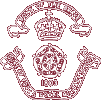


 |
 |
|
 |
||
| Navigation links at the bottom of this page | |||||||||||||||
| Lieutenant George William Hanna, MM | |||||||||||||||
(Editor's note: Mrs. Jennifer Lawson of Australia supplied copies of her family papers and photographs for the preparation of this article. Her help and cooperation is acknowledged with thanks.) |
|||||||||||||||
George William Hanna's father, William John Hanna, was born in Magheralin, Co Down, Ireland, in 1842 according to his army record. He enlisted in the 27th Foot (The Royal Inniskilling Fusiliers) at age 18 and later transferred to the 31st Foot (The Hampshire Regiment). Hanna the elder was one of the legions of Irishmen who enlisted in the British Army during the 19th Century, for the oft-quoted reason no other means of earning a living was available to them. Irish nationals served the British Army throughout the 20th Century, too, but the 19th was a century of heavy Irish enlistment. William Hanna served six years of his military career in India. He spent only the last few months of his service at Tregantle Fort, Whitesand Bay, Cornwall. During the French war (1793-1815), Tregantle guarded the approaches to Devonport. He was fortunate to have served during a period of calm in the colonial wars of the 19th Century British Army. So to have attained the rank of colour sergeant by the age of 36 in 1878 was no mean achievement. Fortunate in one way, Sergeant Hanna was unfortunate in another. He applied for, and was granted, a discharge in 1878, most likely for medical reasons because he was given a pension of eight shillings a week. On his discharge, he moved to Westminster were he married Elizabeth
Trotman. They had three children: George, Mary and John. Disaster struck
the family when George Hanna died at the age of 48. The widow Hanna and
the children continued living at the same at the same address after her
husband died. |
|||||||||||||||
| George William had a long military career that took him to Shorncliffe, Pietermaritzburg (Natal), Bangalore, Rangoon (Burma), and South Africa during the Anglo-Boer War (1901-1902). For service in South Africa he received the Queen's Medal. He also served in World War One and awarded an MM (Military Medal), which his granddaughter, Jennifer Lawson believes was won at the third Battle of Ypres in 1917. He was given a field commission in the rank of Second Lieutenant and later promoted to full Lieutenant. George married Elizabeth Taylor in November 1915 and remained in the Army until his retirement. | |||||||||||||||
|
|||||||||||||||
| Similarly, George's younger brother John had a military career, serving before and during the First World War. John was unquestionable in the school band and played the trombone, for he had a dance band after leaving the army. He married his sweetheart Rose. They had no children of their own, but were closely involved in the lives of George and Elizabeth's family. |
| ||||||||||
|
© A. W. Cockerill 2011 Site Map Contact me | ||||||||||